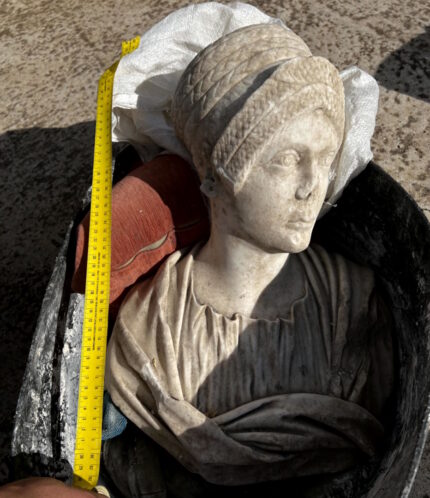 Spain’s Civil Guard police have recovered 119 looted archaeological artifacts from a storage room in Baena (Córdoba). Objects include an exceptional Roman marble portrait bust, a silver denarius minted by Brutus after the assassination of Caesar of which only a handful of examples are known, and a rare type of Corinthian column capital from the 7th century. A married couple residing in Baena have been detained in connection with the raid and have been charged with crimes against Spain’s historical heritage, smuggling and receiving stolen goods.
Spain’s Civil Guard police have recovered 119 looted archaeological artifacts from a storage room in Baena (Córdoba). Objects include an exceptional Roman marble portrait bust, a silver denarius minted by Brutus after the assassination of Caesar of which only a handful of examples are known, and a rare type of Corinthian column capital from the 7th century. A married couple residing in Baena have been detained in connection with the raid and have been charged with crimes against Spain’s historical heritage, smuggling and receiving stolen goods.
The raid (dubbed Operation Plotina after Trajan’s wife) was carried out as part of Project Pandora VII, a massive international anti-smuggling operation led by Spanish police in cooperation with Interpol and Europol. So far, the wide-ranging Pandora investigation has resulted in 60 arrests and 11,049 cultural assets seized from several countries, 19 of the arrests made and 1,079 of the assets seized by the Civil Guard in Spain.
The stand-out object in the Plotina raid is the marble bust. It is a high-quality private portrait of a woman dating to the first third of the 2nd century. The hair style — braids woven into two crescents above the forehead and then coiled into a large bun at the back of the head — is typical of portraits of Salonina Matidia (68-119 A.D.), beloved niece of the emperor Trajan and mother-in-law of his heir Hadrian. Similar examples can be found in the Metropolitan Museum of Art and the British Museum. Only the heads of those portraits are original. The actual bust in the British Museum was a modern recreation. The Matidia-style portrait found in the raid is integral.
The Museum of Córdoba, under the direction of archaeologist Lola Baena, says that “it is an absolutely exceptional piece. It depicts a young woman dressed in a tunic and cloak, the folds and movement of which are carved with great skill. Her head is slightly tilted to the left, her neck is long and slender, and her features conform to a realistic idealized representation, a feature that characterizes Roman portraiture from the High Imperial period (1st-3rd centuries) from Augustus onward. The piece is unquestionably exceptional, and it is on par with the best second-century Roman sculpture made in Hispanic workshops, as well as close to the quality of those from Rome itself.”
The confiscated artifacts have been transferred to the Archaeological Museum of Córdoba for conservation and study.